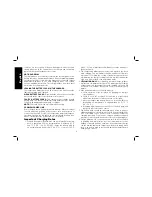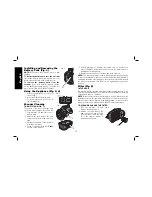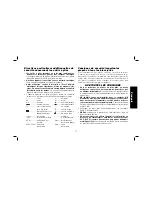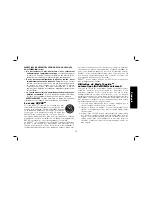
collection site for recycling. If the new battery pack elicits the same
trouble indication as the original, have the charger and the battery
pack tested at an authorized service center.
HOT/COLD DELAY
This charger has a hot/cold delay feature: when the charger detects a
battery that is hot, it automatically starts a delay, suspending charging
until the battery has cooled. After the battery has cooled, the charger
automatically switches to the pack charging mode. This feature
ensures maximum battery life. The red light flashes long, then short
while in the hot/cold delay mode.
LEAVING THE BATTERY PACK IN THE CHARGER
The charger and battery pack can be left connected with the charge
indicator showing pack charged.
WEAK BATTERY PACKS:
Weak batteries will continue to function
but should not be expected to perform as much work.
FAULTY BATTERY PACKS:
This charger will not charge a faulty
battery pack. The charger will indicate faulty battery pack by refusing
to light or by displaying problem pack or charger.
NOTE:
This could also mean a problem with a charger.
PROBLEM POWER LINE
Some chargers have a problem power line indicator. When the charger
is used with some portable power sources such as generators or
sources that convert DC to AC, the charger may temporarily suspend
operation, flashing the red light with two fast blinks followed by a
pause. This indicates the power source is out of limits.
Important Charging Notes
1. Longest life and best performance can be obtained if the battery
pack is charged when the air temperature is between 65 °F
and 75 °F (18 ° – 24 °C). DO NOT charge the battery pack in
an air temperature below +40 °F (+4.5 °C), or above +105 °F
(+40.5 °C). This is important and will prevent serious damage to
the battery pack.
2. The charger and battery pack may become warm to the touch
while charging. This is a normal condition, and does not indicate
a problem. To facilitate the cooling of the battery pack after use,
avoid placing the charger or battery pack in a warm environment
such as in a metal shed or an uninsulated trailer.
3.
LITHIUM ION ONLY:
A cold battery pack will charge at about
half the rate of a warm battery pack. The battery pack will charge
at that slower rate throughout the entire charging cycle and will
not return to maximum charge rate even if the battery pack
warms.
4. If the battery pack does not charge properly:
a.
Check operation of the receptacle by plugging in a lamp or
other appliance;
b.
Check to see if the receptacle is connected to a light switch
which turns the power off when you turn out the lights;
c.
Move the charger and battery pack to a location where the
surrounding air temperature is approximately 65 °F – 75 °F
(18 ° – 24 °C);
d.
If charging problems persist, take the tool, battery pack and
charger to your local service center.
5. The battery pack should be recharged when it fails to produce
sufficient power on jobs which were easily done previously. DO
NOT CONTINUE to use it under these conditions. Follow the
charging procedure. You may also charge a partially used pack
whenever you desire with no adverse effect on the battery pack.
6. Foreign materials of a conductive nature such as, but not limited
to, grinding dust, metal chips, steel wool, aluminum foil, or any
buildup of metallic particles should be kept away from charger
cavities. Always unplug the charger from the power supply when
there is no battery pack in the cavity. Unplug the charger before
attempting to clean it.
English
8
Summary of Contents for DCV580
Page 2: ......











































